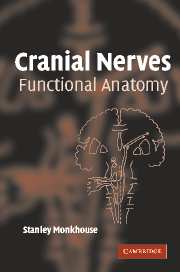Book contents
- Frontmatter
- Contents
- List of Figures
- List of Tables
- Acknowledgements
- A note to the reader
- Part I Organization of the cranial nerves
- Part II-V Individual cranial nerves and functional considerations
- Part II Trigeminal, facial and hypoglossal nerves
- Part III Glossopharyngeal, vagus and accessory nerves
- 13 Swallowing and speaking, bulbar palsy, pseudobulbar palsy, Broca's area
- 14 The glossopharyngeal nerve (IX)
- 15 The vagus nerve (X)
- 16 The accessory nerve (XI)
- Part IV Autonomic components of cranial nerves, taste and smell
- Part V Vision, eye movements, hearing and balance: optic, oculomotor, trochlear, abducens and vestibulocochlear nerves
- Further reading
- Index
13 - Swallowing and speaking, bulbar palsy, pseudobulbar palsy, Broca's area
Published online by Cambridge University Press: 25 August 2009
- Frontmatter
- Contents
- List of Figures
- List of Tables
- Acknowledgements
- A note to the reader
- Part I Organization of the cranial nerves
- Part II-V Individual cranial nerves and functional considerations
- Part II Trigeminal, facial and hypoglossal nerves
- Part III Glossopharyngeal, vagus and accessory nerves
- 13 Swallowing and speaking, bulbar palsy, pseudobulbar palsy, Broca's area
- 14 The glossopharyngeal nerve (IX)
- 15 The vagus nerve (X)
- 16 The accessory nerve (XI)
- Part IV Autonomic components of cranial nerves, taste and smell
- Part V Vision, eye movements, hearing and balance: optic, oculomotor, trochlear, abducens and vestibulocochlear nerves
- Further reading
- Index
Summary
Swallowing
When food or drink passes on to the posterior part of the tongue, the muscles supplied by the nucleus ambiguus through the vagus (X) and glossopharyngeal (IX) nerves propel it backwards and downwards into the hypopharynx, thence through the cricopharyngeal sphincter to the oesophagus. The nasopharynx is closed by the palatal muscles (X, Vc), and the Eustachian tube opens (X). The laryngeal orifice is reduced in size largely as a result of elevation of the entire laryngeal skeleton by all the muscles attaching to it from above, and the cricopharyngeal sphincter opens (X). The tongue muscles (XII) also have an important role in these actions. Most of the muscles of the pharynx are supplied in one way or another by the nucleus ambiguus through the vagus (it is unnecessary to bother with individual pharyngeal muscles).
Sensation from this region is conveyed through the pharyngeal plexus, the glossopharyngeal (posterior tongue, oropharynx) and vagus (hypopharynx) nerves, to the nucleus of the solitary tract.
Speaking
Noise production: phonation
The vocal cords create the narrow slit through which air is directed to make a sound, much as in an oboe, recorder or organ pipe. Muscles which move the cords are supplied by the recurrent laryngeal nerve (X).
Making the noise intelligible: articulation
The pharyngeal muscles (X), the tongue (XII), the muscles of facial expression (VII), mandibular movements (Vc) and the palate (X, V) all modify the crude noise produced by the larynx to create speech.
- Type
- Chapter
- Information
- Cranial NervesFunctional Anatomy, pp. 79 - 82Publisher: Cambridge University PressPrint publication year: 2005

